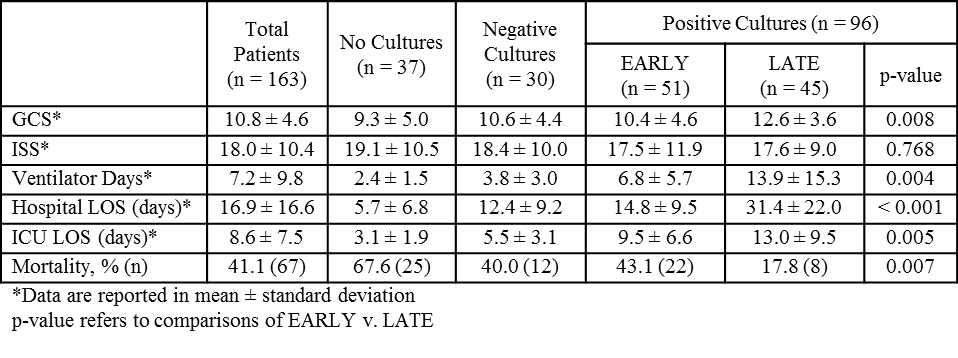A. Ko1, M. Y. Harada1, G. Barmparas1, G. M. Thomsen1, E. Smith1, T. Li1, B. J. Sun1, E. J. Ley1 1Cedars-Sinai Medical Center,Division Of Trauma And Critical Care,Los Angeles, CA, USA
Introduction: Elderly trauma patients are likely to be vulnerable to infection and at increased risk of delayed death. When ventilated, the elderly are at high risk for infection so increased culture surveillance may be indicated. How mortality is affected by early infections compared to later infections is not well described. If mortality is increased with early infections, sending empiric cultures at admission, termed damage control cultures, may better diagnose and treat these patients. We sought to investigate whether an early infection predicts higher mortality in ventilated elderly trauma patients.
Methods: We conducted a retrospective review of all mechanically ventilated trauma patients age ≥ 65 years admitted between January 1, 2009 and December 31, 2013 at a Level 1 trauma center. Clinical data and sputum, blood, and urine culture results were collected. Patients with a positive culture within 4 days of admission (EARLY) were compared to those with a positive culture after 4 days (LATE).
Results: A total of 163 elderly trauma patients requiring ventilator support were identified, of whom 126 (77.3%) had cultures sent during hospitalization. Of these cultured patients, 96 (76.2%) had at least one positive culture. Fifty-one (53.1%) were EARLY and 46 (46.9%) were LATE. The two cohorts were similar in age, gender, admission systolic blood pressure (SBP), mechanism of injury, and injury severity score (ISS). The EARLY cohort had lower admission GCS (10.4 ± 4.6 v. 12.6 ± 3.6, p = 0.008), shorter ventilator days (6.8 ± 5.7 v. 13.9 ± 15.3, p = 0.004), hospital length of stay (LOS) (14.8 ± 9.5 v. 31.4 ± 22.0, p < 0.001), intensive care unit (ICU) LOS (9.5 ± 6.6 v. 13.0 ± 9.5, p = 0.005), but higher mortality (43.1% v. 17.8%, p = 0.007). Multivariate analysis demonstrated that having an early positive culture was a predictor of higher mortality (AOR 3.77, p = 0.008).
Conclusion: Early infection in mechanically ventilated elderly trauma patients is associated with high mortality. Damage control cultures in this population may identify early infections, allowing for early treatment with reduced mortality.
